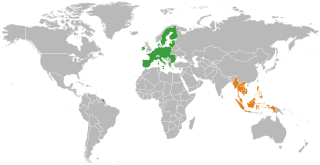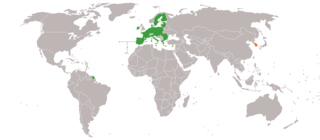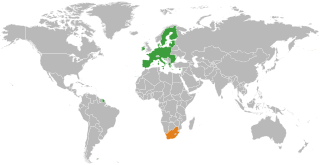
The economy of Morocco is considered relatively liberal, governed by the law of supply and demand. Since 1993, in line with many Western world changes, Morocco has followed a policy of privatisation. Morocco has become a major player in African economic affairs, and is the 6th largest African economy by GDP (PPP). The World Economic Forum placed Morocco as the most competitive economy in North Africa, in its African Competitiveness Report 2014–2015.
The Australia – United States Free Trade Agreement (AUSFTA) is a preferential trade agreement between Australia and the United States modelled on the North American Free Trade Agreement (NAFTA). The AUSFTA was signed on 18 May 2004 and came into effect on 1 January 2005.
The US-Morocco Free Trade Agreement is a bilateral trade agreement between the United States and Morocco. The agreement was signed on June 15, 2004, followed by U.S. President George W. Bush's signing of the USMFTA Implementation Act on August 17, 2004. The United States House of Representatives ratified the pact on July 22, 2004 by a 323–99 vote. The United States Senate passed the bill by unanimous consent on July 21, 2004. The Morocco FTA came into effect on January 1, 2006.
The United States–Israel States Free Trade Agreement (FTA) is a trade pact between the State of Israel and the United States of America established in 1985 to lower trade barriers in some goods. The agreement reduces rates of duty, and in some case eliminates all duties, on merchandise exported from Israel to the United States. The agreement also covers merchandise exported from the Gaza Strip and the West Bank.
The United States-Colombia Trade Promotion Agreement (CTPA) is a bilateral free trade agreement between the United States and Colombia. Sometimes called the Colombia Free Trade Agreement, it was signed on November 22, 2006, by Deputy U.S. Trade Representative John Veroneau and Colombian Minister of Trade, Industry, and Tourism Jorge Humberto Botero. CTPA is a comprehensive agreement that will eliminate tariffs and other barriers to trade in goods and services between the United States and Colombia, including government procurement, investment, telecommunications, electronics commerce, intellectual property rights, and labor and environmental protection The United States Congress. Colombia's Congress approved the agreement and a protocol of amendment in 2007. Colombia's Constitutional Court completed its review in July 2008, and concluded that the Agreement conforms to Colombia's Constitution. President Obama tasked the Office of the U.S. Trade Representative with seeking a path to address outstanding issues surrounding the Colombia FTA. The United States Congress then took on the agreement and passed it on October 12, 2011. The agreement went into effect on May 15, 2012.

The United States–Korea Free Trade Agreement, also known as KORUS FTA, is a trade agreement between the United States and South Korea. Negotiations were announced on February 2, 2006, and concluded on April 1, 2007. The treaty was first signed on June 30, 2007, with a renegotiated version signed in early December 2010.

The ASEAN–European Union relations are the bilateral foreign relations between the two organisations; the European Union (EU), and the Association of Southeast Asian Nations (ASEAN). EU and ASEAN have been interacting with each other on the economic, trade, and political levels for more than four decades. The partnership between the EU and ASEAN dates back to 1972, when the EU established ties with ASEAN. The EU became an ASEAN Dialogue Partner in 1977.

The European Union–South Korea Free Trade Agreement is a free trade agreement between the European Union (EU) and South Korea. The agreement was signed on 15 October 2009. The agreement was provisionally applied from 1 July 2011, and entered into force from 13 December 2015, after having been ratified by all signatories.
Morocco–Pakistan relations have traditionally been strong and cordial, since their establishment in the 1950s. Morocco maintains an embassy in Islamabad, whilst Pakistan maintains one in Rabat. Both countries are members of the Organisation of Islamic Cooperation, Group of 77 and Non-Aligned Movement.
The ASEAN–India Free Trade Area (AIFTA) is a free trade area among the ten member states of the Association of Southeast Asian Nations (ASEAN) and the Republic of India. The initial framework agreement was signed on 8 October 2003 in Bali, Indonesia. and the final agreement was on 13 August 2009. The free trade area came into effect on 1 January 2010. India hosted the latest ASEAN-India Commemorative Summit in New Delhi on 26 January 2018. In the financial year 2017–18, Indo-ASEAN bilateral trade grew by almost 14% to reach US$81.3 billion. India's imports from ASEAN were valued at US$47.13 billion while its exports to ASEAN stood at US$34.2 billion.

Relations between the European Union and the Republic of India are currently defined by the 1994 EU–India Cooperation Agreement. The EU is a significant trade partner for India and the two sides have been attempting to negotiate a free trade deal since 2007. Indo-EU bilateral trade stood at US$104.3 billion in the financial year 2018–19.
Since the end of apartheid, foreign trade in South Africa has increased, following the lifting of several sanctions and boycotts which were imposed as a means of ending apartheid.

Pakistan has bilateral and multilateral trade agreements with many nations and international organizations. It is a member of the World Trade Organization, part of the South Asian Free Trade Area agreement and the China–Pakistan Free Trade Agreement. Fluctuating world demand for its exports, domestic political uncertainty, and the impact of occasional droughts on its agricultural production have all contributed to variability in Pakistan's trade deficit. The trade deficit for the fiscal year 2013/14 is $7.743 billion, exports are $10.367 billion in July–November 2013 and imports are $18.110 billion.

The European Union (EU) has strong cultural and historical links to South Africa and the EU is South Africa's biggest investor.

Relations between the European Union (EU) and Japan date back to 1959. They have a strong trade relationship, particularly in investment flows.

The European Union (EU) and South Korea are important trade partners: As of April 2023, Korea is the EU's third-largest importer. Excluding European countries, Korea has secured the third place on the list, following China and the United States. And the EU is Korea's third largest export destination. The two have signed a free trade agreement which came into effect at end of 2011. Furthermore, South Korea is the only country in the world with the three agreements covering economics, politics and security in effect as of 2020.

The China–Pakistan Free Trade Agreement(CPFTA) is a free trade agreement (FTA) between the People's Republic of China and the Islamic Republic of Pakistan that seeks to increase trade and strengthen the partnership between the two countries.
The European Union and Indonesia have built robust commercial relations, with bilateral trade amounting to approximately €25 billion in 2012 resulting in a sizeable €5.7 billion trade surplus for Indonesia with the EU. As of 2012 EU and Indonesia has been marked by an upward trend. Whereas total trade was worth almost €16 billion in 2009, by 2011 it had already reached €23.5 billion.
The trade policy of Switzerland refers to Switzerland's approach to importing and exporting with other countries.









